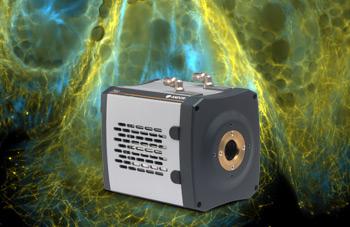8 Jun
Neo sCMOS Notice of Discontinuance
Obsolescence Process for Neo sCMOS

On 2nd June 2023, Andor’s Neo sCMOS camera was formally discontinued and can no longer be ordered. From this point, a further 3 months will be allowed for any remaining existing orders to be built and delivered. Following this, on 2nd September 2023, the Neo will officially be listed as obsolete.
Full details of the terms of obsolescence and continued support timescales can be obtained from Andor’s obsolescence policy.
What was Neo sCMOS and why was it Used?
Neo was a 5.5 Megapixel cooled sCMOS camera with a 2560(h) x 2160 sensor format, 6.5 µm pixel size and QEmax. 60%. It offered both Rolling and Global Shutter and delivered 30 fps through a CameraLink 3-tap data interface.
The 5.5 Megapixel sensor made it appealing for applications that needed to extend field of view at high resolution, such as light sheet microscopy on large samples or high content screening in drug discovery.
The true Global Shutter mode rendered it useful for Fluid Dynamics using Particle Imaging Velocimetry, delivering double exposure with < 1 µs intra-frame optical resolution.
Recommended Alternatives for Physical Sciences and Astronomy
- ZL41 Wave 5.5 – Using the same sCMOS sensor as Neo, ZL41 Wave 5.5 offers the same large field of view and high resolution and is designed specifically for physical science applications. This cost-effective workhorse camera has a large 5.5 Megapixel sensor, making it ideal for astronomy large sky surveys or X-Ray tomography. Achieving 40 fps via USB3 and 100 fps through a CameraLink 10-tap interface, this model is superb for fast quantum imaging or hyperspectral imaging. The Global Shutter functionality renders this model ideal for Fluid Dynamics using Particle Imaging Velocimetry, with < 1 µs intra-frame optical resolution between double frames. Global Shutter is also ideal for imaging fast moving objects without distortion.
- ZL41 Wave 4.2 – Using a 4.2 Megapixel sensor, this model offers a very high 82% QE and Rolling Shutter mode. A superb price/performance workhorse camera, the enhanced sensitivity makes it an ideal solution for imaging or spectroscopic measurement/characterisation of low concentrations of material or detecting weak/small celestial objects, including transitory behaviour. Achieving 53 fps via USB3 and 100 fps through CameraLink 10-tap interface, ZL4
Recommended Alternatives for Fluorescence Microscopy
- ZL41 Cell 5.5 – Using the same sCMOS sensor as Neo, ZL41 Cell 5.5 offers the same large field of view and high resolution and is designed specifically for microscopy. However, ZL41 Cell 5.5 is faster than Neo, achieving 40 fps via USB3 and 100 fps through a CameraLink 10-tap interface. Global Shutter capability is useful for snapshot imaging of fast objects, such as flowing cells, free of motion artefacts.
- ZL41 Cell 4.2 – Using a 4.2 Megapixel sensor, this model offers a very high 82% QE and Rolling Shutter mode. It is also available with SRRF-Stream+, the most cost-effective and easy way to add super-resolution down to ~100 nm to your existing fluorescence microscope, whether widefield, spinning disk confocal or TIRF.

